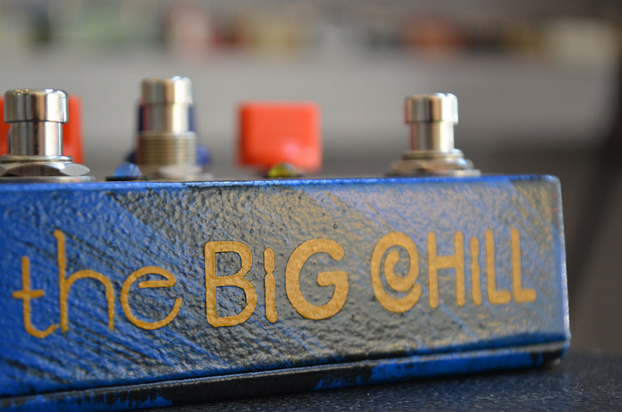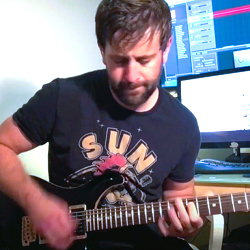Guitar Chalk Sessions: Three Nuanced Quality Indicators of a Good Tremolo Pedal

This is an abridged and shorter version of a lengthier article highlighting seven tremolo pedals that fit the descriptors mentioned here.
Tremolo is an incredibly simple effect.
In its most raw form, it’s little more than the raising and lowering of your signal’s volume.
And not only is tremolo one of the oldest and most recognized effects in the electric guitar’s history, it’s also been traditionally implemented via analog circuitry within amplifiers.
Today there are still a lot of amps on the market that come packaged with a tremolo effect.
To name a few:
•VOX AC15C2
•Fender ‘68 Custom Vibrolux
•Marshall 1973X
Get The Pick Newsletter
All the latest guitar news, interviews, lessons, reviews, deals and more, direct to your inbox!
These amps (among many others) carry their own tremolo that’s built-into the amp’s channels and ready to use. More often than not, they sound pretty good.
But what if we don’t own an amp with tremolo built-in?
Further, what if we just don’t like it? A lot of guitar players prefer their effects in a stompbox on the floor in front of them. If that’s the team you’re on, you might wonder, “What is there to know about tremolo pedals in the digital age?”
Or what quality indicators do you look for if you’re going to buy one?
While the difference between a “good” and “bad” tremolo pedal is a smaller gap than a good and bad delay, there are still some quality indicators to be aware of.
And they can be difficult to spot if you don’t know what you’re looking for.
There are primarily three of these indicators.
1. The Waveform Selector
There’s some digital processing science and mathematics that go into what a waveform actually is, but for our purposes, a tremolo waveform is essentially the pattern that the volume sweep of the effect will follow.
There are primarily three different waveforms that a tremolo can take:
1. Square
2. Peak
3. Sine
On cheaper or lower-quality tremolo pedals, the default tremolo waveform will be sine and will likely go unmentioned.
Better quality tremolo pedals, that you can get in guitar shops like Long and McQuade or from boutique manufacturers, will often give you a switch that allows you to toggle between all three. It’s easily spotted on pedals like the Wampler Latitude Deluxe:

Those three squiggly lines underneath the switch represent the three waveforms. From left to right, square, peak and sine.
This gives your pedal a significantly more versatile array of sounds and provides the entire spectrum of the tremolo effect.
2. Correcting the “Volume-Drop Problem”
Though tremolo is a simple effect, it’s notorious for causing what’s known as the “volume-drop problem.”
This occurs because of the constant raising and lowering (sweeping) of your signal’s volume. That means your tremolo effect sets a low and a peak, where the peak will always match the volume of your guitar’s signal output.
This is fine, except for the fact that a majority of the effect’s time is spent between the peaks, giving the illusion that your guitar’s volume has been lowered.
Good tremolo pedals correct this by adding an external volume knob, like the one on Robert Keeley’s Boss TR-2 mod.
Other tremolo pedals deal with the problem via interior circuitry, but it’s always something to keep in mind when you’re scoping them out.
3. Depth and Tone Customization
It’s tempting to assume that all a tremolo pedal really needs is a depth and rate knob. After all, it is a fairly basic modulation effect.
But the higher-quality tremolo pedals pack a lot of customization into their boxes.
Consider, for example, the Strymon Flint Tremolo and Reverb with the following parameters:
Intensity / Speed / Mix / Decay / Color
That’s not even mentioning the three different tremolo modes and the optional expression pedal. All this is not to say that you can’t do well with a more basic configuration, but know that the tweaking options are out there.
And in many cases they’re worth the extra investment.
Why not just stick with the amp?
A lot of guitarists are strictly analog, which means the tremolo pedals of our day might fall flat as they’re usually analog simulations via digital circuitry.
So there’s a case to be made for sticking with what might be considered a simpler and more pure form of the effect.
It’s really just a matter of preference.
Because there are advantages to both. But if you’re going to go the pedal route (which is my personal preference) it pays to know where you’re going to get the most quality and what the most desirable features of a tremolo pedal are.
Besides, waveforms make great dinner-table conversation.
Your Thoughts
Have thoughts or insight into tremolo pedals and their quality indicators? Feel free to share them in the comments section or hit us up via Twitter and Facebook. We can always learn more from each other.
Flickr Commons Image Courtesy of GigNroll
Robert Kittleberger is the editor of Guitar Chalk and a staff writer at Guitar Tricks. You can get in touch with him here or via Twitter and Facebook.
Bobby is the founder of Guitar Chalk, and responsible for developing most of its content. He has worked with leading guitar industry companies including Sweetwater, Ultimate Guitar, Seymour Duncan, PRS, and many others.
“Sonically excellent… we found that it could be a viable substitute for our vintage 1970s pedals”: Hamstead x That Pedal Show Redwing Analogue Stereo Modulator review
“The original Jordan Boss Tone was probably used by four out of five garage bands in the late ’60s”: Unpacking the gnarly magic of the Jordan Boss Tone – an actual guitar plug-in that delivers Dan Auerbach-approved fuzz


![John Mayer and Bob Weir [left] of Dead & Company photographed against a grey background. Mayer wears a blue overshirt and has his signature Silver Sky on his shoulder. Weir wears grey and a bolo tie.](https://cdn.mos.cms.futurecdn.net/C6niSAybzVCHoYcpJ8ZZgE.jpg)

![A black-and-white action shot of Sergeant Thunderhoof perform live: [from left] Mark Sayer, Dan Flitcroft, Jim Camp and Josh Gallop](https://cdn.mos.cms.futurecdn.net/am3UhJbsxAE239XRRZ8zC8.jpg)






